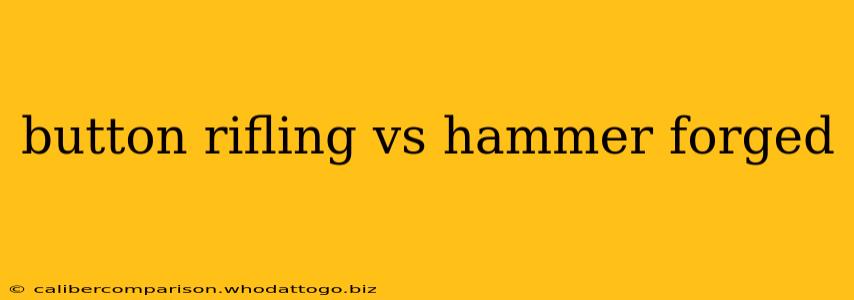Choosing the right barrel for your firearm is a crucial decision impacting accuracy, longevity, and overall performance. Two prominent manufacturing processes dominate the market: button rifling and hammer forging. This in-depth comparison explores the strengths and weaknesses of each, helping you make an informed choice.
Understanding Button Rifling
Button rifling is a relatively modern process employing a hardened steel tool, the "button," to cut the rifling grooves into the barrel's interior. This button is precisely engineered to match the desired rifling twist rate and groove profile. The button is drawn through the barrel blank under immense pressure, cold-forming the grooves and leaving a highly polished finish.
Advantages of Button Rifling:
- High Accuracy Potential: The cold-working process creates a consistently precise rifling pattern, leading to potentially higher accuracy compared to hammer forging. The lack of heat minimizes material expansion and distortion.
- Excellent Surface Finish: The button leaves a smooth, polished bore, reducing friction and improving projectile velocity. This smoother finish also contributes to increased accuracy and barrel life.
- Cost-Effective for High-Volume Production: While the initial tooling investment is substantial, button rifling is efficient for mass production, potentially lowering the overall cost per barrel.
- Consistent Rifling: The process ensures consistent rifling throughout the barrel, unlike some hammer-forged barrels which can display minor variations.
Disadvantages of Button Rifling:
- Tooling Costs: Designing and creating the button tooling requires a significant upfront investment, making it less suitable for small-batch production.
- Limited Rifling Profiles: Creating highly complex rifling profiles can be challenging and might require multiple buttons, increasing complexity and cost.
- Material Limitations: Button rifling may not be ideal for all materials, potentially limiting choices for certain firearm applications.
Understanding Hammer Forging
Hammer forging, a more traditional method, utilizes a forging hammer to shape the barrel blank around a mandrel with the desired rifling pattern already impressed upon it. The intense heat and pressure during forging create the rifling and strengthen the barrel's steel.
Advantages of Hammer Forging:
- Strength and Durability: The forging process strengthens the steel, creating a durable barrel that can withstand high pressures and extended use.
- Flexibility in Barrel Design: Hammer forging offers greater flexibility in designing complex barrel profiles, including different contours and shapes.
- Suitable for Various Materials: Hammer forging is adaptable to a wider range of materials compared to button rifling.
Disadvantages of Hammer Forging:
- Accuracy Variations: The high heat involved can lead to slight inconsistencies in the rifling, potentially affecting accuracy.
- Rougher Surface Finish: The hammer-forged barrels typically have a rougher bore finish compared to button-rifled barrels, resulting in more friction and potentially faster barrel wear.
- Higher Production Costs: Forging is generally a more labor-intensive process than button rifling, leading to potentially higher costs, especially for smaller-scale production.
Button Rifling vs. Hammer Forging: The Verdict
Both button rifling and hammer forging produce high-quality barrels, but their strengths lie in different areas. Button rifling excels in accuracy and consistency, particularly beneficial for precision shooting applications. Hammer forging shines in durability and versatility, making it suitable for various applications, especially where robustness is paramount. The ultimate choice depends on the specific needs and priorities of the firearm and shooter. Consider the intended use, desired level of accuracy, budget constraints, and the type of firearm when making your decision. A higher-end, button-rifled barrel will likely offer superior accuracy, while a hammer-forged barrel might provide better durability for heavier use.

